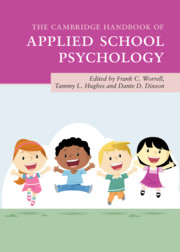Book contents
- The Cambridge Handbook of Applied School Psychology
- The Cambridge Handbook of Applied School Psychology
- Copyright page
- Contents
- Contributors
- Contributor Biographies
- Acknowledgments
- 1 Broadening the Focus of School Psychology Practice
- Part I Individual-Level Academic Interventions
- Part II Teacher- and System-Level Interventions
- Part III Interventions from Educational and Social/Personality Psychology
- 10 Belonging in Schools: A Social Psychological Perspective
- 11 Cross-Race/Ethnic Friendships in School
- 12 Self-Regulated Learning in School Contexts
- 13 School Environments that Facilitate Delaying Gratification
- 14 Understanding and Cultivating Hope in School
- 15 School Settings that Facilitate High Teacher Expectations
- 16 Parental Autonomy and Relatedness Support
- 17 Preventing and Minimizing Stereotype Threat in School Settings
- 18 The Hidden Classroom: How Gender Stereotypes Impact Academic Achievement
- Part IV Behavioral and Social-Emotional Interventions
- Part V Health and Pediatric Interventions
- Part VI Family Connections and Life Transitions
- Part VII Special Populations
- Part VIII Conclusion
- Index
- References
11 - Cross-Race/Ethnic Friendships in School
from Part III - Interventions from Educational and Social/Personality Psychology
Published online by Cambridge University Press: 18 September 2020
- The Cambridge Handbook of Applied School Psychology
- The Cambridge Handbook of Applied School Psychology
- Copyright page
- Contents
- Contributors
- Contributor Biographies
- Acknowledgments
- 1 Broadening the Focus of School Psychology Practice
- Part I Individual-Level Academic Interventions
- Part II Teacher- and System-Level Interventions
- Part III Interventions from Educational and Social/Personality Psychology
- 10 Belonging in Schools: A Social Psychological Perspective
- 11 Cross-Race/Ethnic Friendships in School
- 12 Self-Regulated Learning in School Contexts
- 13 School Environments that Facilitate Delaying Gratification
- 14 Understanding and Cultivating Hope in School
- 15 School Settings that Facilitate High Teacher Expectations
- 16 Parental Autonomy and Relatedness Support
- 17 Preventing and Minimizing Stereotype Threat in School Settings
- 18 The Hidden Classroom: How Gender Stereotypes Impact Academic Achievement
- Part IV Behavioral and Social-Emotional Interventions
- Part V Health and Pediatric Interventions
- Part VI Family Connections and Life Transitions
- Part VII Special Populations
- Part VIII Conclusion
- Index
- References
Summary
In this chapter, current research on cross-race/ethnic friendships of children and adolescents in school settings is reviewed. In the first part of the chapter, research on the prevalence, meaning, and function of cross-race/ethnic friendships is discussed. The second section considers school organizational and instructional practices, such as academic tracking, that might interfere with the opportunity to form cross-race/ethnic friendships even in ethnically diverse schools. The third section reviews school-based interventions, including prejudice reduction programs, that can promote the development of friendships that cross racial and ethnic boundaries. The chapter concludes with reflections on promising directions for future research. Harnessing the power of cross-race/ethnic friendships may be critical for promoting tolerance of multiple groups in this era of increasingly racial/ethnic diversity.
Keywords
- Type
- Chapter
- Information
- The Cambridge Handbook of Applied School Psychology , pp. 170 - 193Publisher: Cambridge University PressPrint publication year: 2020



